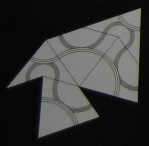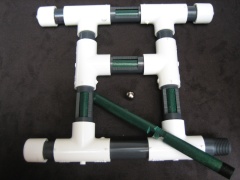The Ooo Tray
Every year, a group of volunteers puts on a one-day puzzle event for Microsoft's summer interns here on the Redmond campus called Intern Puzzleday. It's kind of a scaled-down version of the more well-known (and ambitious) Microsoft Puzzlehunt events. Although Puzzlehunt traditionally begins at about 10am on Saturday and continues straight through to dinner time on Sunday, Intern Puzzleday is a kinder, gentler one-day affair, almost exactly 24 hours shorter than Puzzlehunt.
This year, I had the great fun of joining the team of volunteers putting on Puzzleday 2007, and I designed or co-designed five different puzzles for the event, three of which we finally used on the day itself. Perhaps I'll write a fuller description of the event later, but for now I'll just show one of the puzzles I designed for it.
Traditionally, Puzzlehunt and Puzzleday puzzles are designed to have a short, one- or two-word answer that solvers can type into email or a web page to prove that they've finished. All of those answers are later used in one or more layers of "meta-puzzles" leading eventually to a final "hunt" somewhere on campus for an artifact specific to that hunt's theme.
I wanted to find some way to incorporate a mechanical puzzle into this domain that's typically dominated by paper-and-pencil or on-site-event puzzles. To do so, I started with the tray and piece design from my "Perkinson Guest Bathroom Tile" puzzle and laser-engraved some additional information on both. The result is, I think, something new in the world of mechanical puzzles: a puzzle with an answer, not just a solution. In this case, the answer is just one word long, and finding it takes you through a multi-layer solving experience; guidance for the first layer is etched right onto the tray ("Place all twelve pieces flat in the tray"), and solving each layer reveals more guidance on how to attack the next one. There are a total of three or four layers to this seemingly simple puzzle, depending on how you count. During Puzzleday, the Ooo Tray was solved by all 28 teams of interns, and it was the first puzzle that many teams worked on.
Update:
I'm now making this puzzle in beautiful natural cherry! I've also tightened up the design slightly from the original to give the puzzle a somewhat nicer look and an even more satisfying ending.

